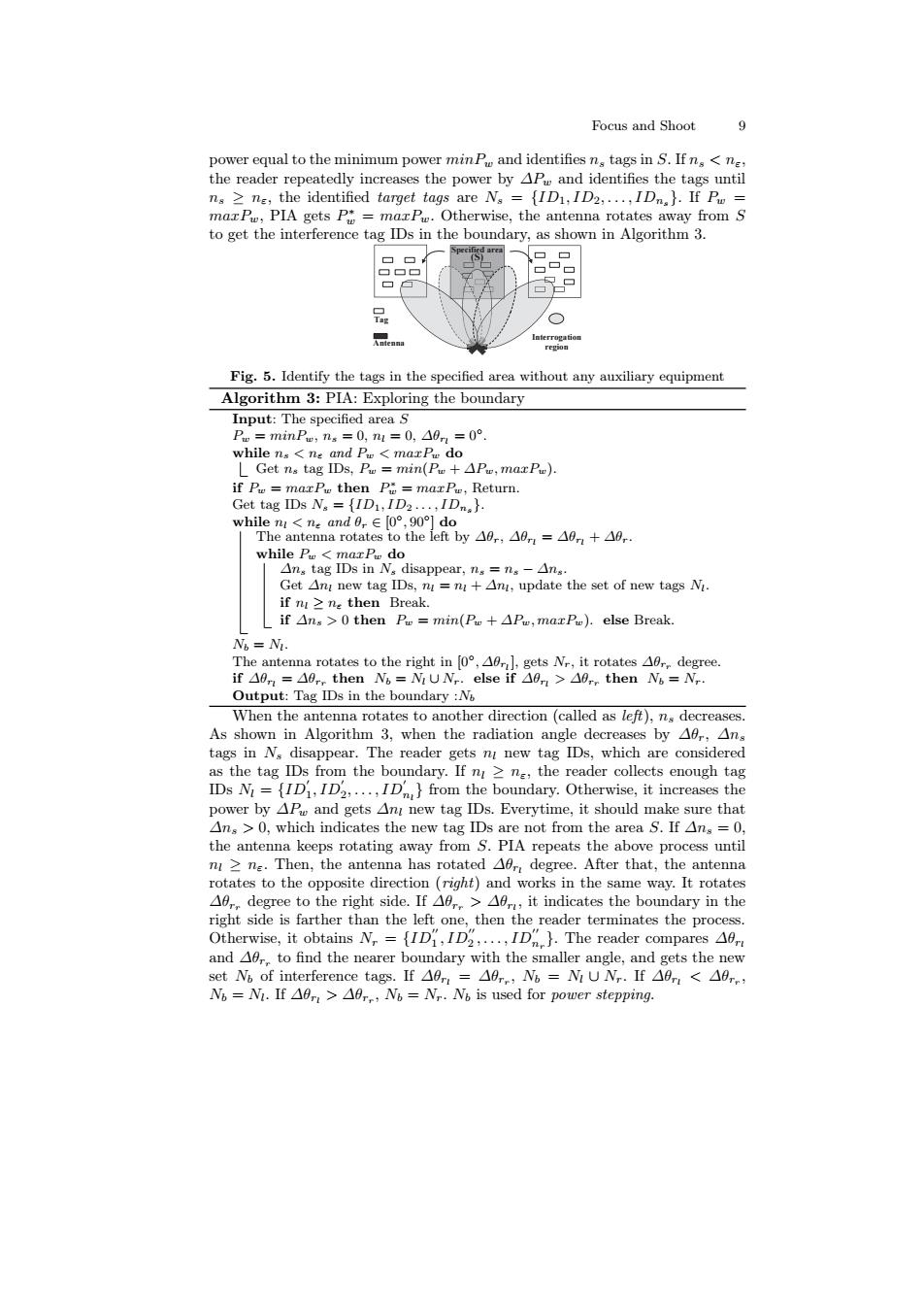正在加载图片...

Focus and Shoot 9 power equal to the minimum power min P and identifies ns tags in S.If ns<ne, the reader repeatedly increases the power by Ap and identifies the tags until ns ne,the identified target tags are N =(ID1,ID2,...,IDn}.If Pu= marP,PIA gets P=marP.Otherwise,the antenna rotates away from S to get the interference tag IDs in the boundary,as shown in Algorithm 3. Pecmied area Anicmna Fig.5.Identify the tags in the specified area without any auxiliary equipment Algorithm 3:PIA:Exploring the boundary Input:The specified area S Pm=minPw,ns=0,nu=0,△0n=0° while ns ne and Pw<mazP do Get ns tag IDs,P min(Pu +AP,maxPu). if Pu=maxPu then P=maxPu,Return. Get tag IDs N.={ID1,ID2...,ID}. while n<ne and0,∈[0°,90]do The antenna rotates to the left by△0,△onm=△on+△or while P<maxP do |△n tag IDs in N.disappear,ns=ns-△ns: Get An new tag IDs,n =n+An,update the set of new tags N. ifnu≥ne then Break if Ans >0 then Pe=min(P+AP,marP).else Break N6=N. The antenna rotates to the right in [0°,△or,l,gets Nr,it rotates△ar,degree if△0nm=△9,then N6=NUNr.else if△0rm>△0r,then N=N Output:Tag IDs in the boundary N When the antenna rotates to another direction (called as left),ns decreases As shown in Algorithm 3,when the radiation angle decreases by A0r,Ans tags in N.disappear.The reader gets n new tag IDs,which are considered as the tag IDs from the boundary.If n>n,the reader collects enough tag IDs N=[ID1,ID2,...,ID}from the boundary.Otherwise,it increases the power by AP and gets An new tag IDs.Everytime,it should make sure that Ans>0,which indicates the new tag IDs are not from the area S.If Ans=0. the antenna keeps rotating away from S.PIA repeats the above process until n>n.Then,the antenna has rotated Adr,degree.After that,the antenna rotates to the opposite direction (right)and works in the same way.It rotates Aer,degree to the right side.If Aer>Aor,it indicates the boundary in the right side is farther than the left one,then the reader terminates the process. Otherwise,it obtains N=[ID1,ID2,...,ID}.The reader compares Ar and A0r,to find the nearer boundary with the smaller angle,and gets the new set N of interference tags.f△9,1=△9r,V%=NUNr.If△9n1<△0,., N%=N.If△9,>△0,Nb=Nr.No is used for power stepping-Focus and Shoot 9 power equal to the minimum power minPw and identifies ns tags in S. If ns < nε, the reader repeatedly increases the power by ∆Pw and identifies the tags until ns ≥ nε, the identified target tags are Ns = {ID1, ID2, . . . , IDns }. If Pw = maxPw, PIA gets P ∗ w = maxPw. Otherwise, the antenna rotates away from S to get the interference tag IDs in the boundary, as shown in Algorithm 3. Interrogation region Tag Antenna Specified area (S) Fig. 5. Identify the tags in the specified area without any auxiliary equipment Algorithm 3: PIA: Exploring the boundary Input: The specified area S Pw = minPw, ns = 0, nl = 0, ∆θrl = 0◦ . while ns < nε and Pw < maxPw do Get ns tag IDs, Pw = min(Pw + ∆Pw, maxPw). if Pw = maxPw then P ∗ w = maxPw, Return. Get tag IDs Ns = {ID1, ID2 . . . , IDns }. while nl < nε and θr ∈ [0◦ , 90◦ ] do The antenna rotates to the left by ∆θr, ∆θrl = ∆θrl + ∆θr. while Pw < maxPw do ∆ns tag IDs in Ns disappear, ns = ns − ∆ns. Get ∆nl new tag IDs, nl = nl + ∆nl, update the set of new tags Nl. if nl ≥ nε then Break. if ∆ns > 0 then Pw = min(Pw + ∆Pw, maxPw). else Break. Nb = Nl. The antenna rotates to the right in [0◦ , ∆θrl ], gets Nr, it rotates ∆θrr degree. if ∆θrl = ∆θrr then Nb = Nl ∪ Nr. else if ∆θrl > ∆θrr then Nb = Nr. Output: Tag IDs in the boundary :Nb When the antenna rotates to another direction (called as left), ns decreases. As shown in Algorithm 3, when the radiation angle decreases by ∆θr, ∆ns tags in Ns disappear. The reader gets nl new tag IDs, which are considered as the tag IDs from the boundary. If nl ≥ nε, the reader collects enough tag IDs Nl = {ID′ 1 , ID′ 2 , . . . , ID′ nl } from the boundary. Otherwise, it increases the power by ∆Pw and gets ∆nl new tag IDs. Everytime, it should make sure that ∆ns > 0, which indicates the new tag IDs are not from the area S. If ∆ns = 0, the antenna keeps rotating away from S. PIA repeats the above process until nl ≥ nε. Then, the antenna has rotated ∆θrl degree. After that, the antenna rotates to the opposite direction (right) and works in the same way. It rotates ∆θrr degree to the right side. If ∆θrr > ∆θrl , it indicates the boundary in the right side is farther than the left one, then the reader terminates the process. Otherwise, it obtains Nr = {ID′′ 1 , ID′′ 2 , . . . , ID′′ nr }. The reader compares ∆θrl and ∆θrr to find the nearer boundary with the smaller angle, and gets the new set Nb of interference tags. If ∆θrl = ∆θrr , Nb = Nl ∪ Nr. If ∆θrl < ∆θrr , Nb = Nl . If ∆θrl > ∆θrr , Nb = Nr. Nb is used for power stepping